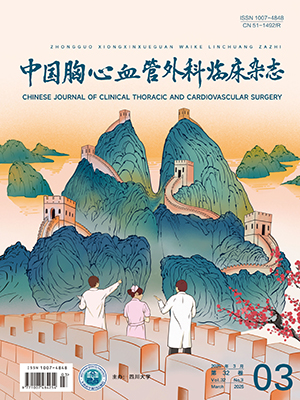| 1. |
Siegel RL, Miller KD, Jemal A. Cancer statistics, 2017. CA Cancer J Clin, 2017, 67(1): 7-30.
|
| 2. |
Detterbeck FC, Lewis SZ, Diekemper R, et al. Executive summary: Diagnosis and management of lung cancer, 3rd ed: American College of Chest Physicians evidence-based clinical practice guidelines. Chest, 2013, 143(5 Suppl): 7S-37S.
|
| 3. |
Swanson SJ, Herndon JE, D'Amico TA, et al. Video-assisted thoracic surgery lobectomy: Report of CALGB 39802—A prospective, multi-institution feasibility study. J Clin Oncol, 2007, 25(31): 4993-4997.
|
| 4. |
Paul S, Altorki NK, Sheng S, et al. Thoracoscopic lobectomy is associated with lower morbidity than open lobectomy: A propensity-matched analysis from the STS database. J Thorac Cardiovasc Surg, 2010, 139(2): 366-378.
|
| 5. |
王述民. 达芬奇机器人在肺癌根治术中的应用现状及展望. 中国肿瘤, 2014, 23(9): 736-742.
|
| 6. |
马征, 岳韦名, 高存, 等. 基于倾向性评分匹配法的机器人与胸腔镜辅助胸外科手术治疗肺癌的近期效果比较. 中华胸部外科电子杂志, 2020, 7(4): 208-213.
|
| 7. |
Louie BE, Wilson JL, Kim S, et al. Comparison of video-assisted thoracoscopic surgery and robotic approaches for clinical stage Ⅰ and stageⅡ non-small cell lung cancer using the Society of Thoracic Surgeons Database. Ann Thorac Surg, 2016, 102(3): 917-924.
|
| 8. |
Radkani P, Joshi D, Barot T, et al. Robotic video-assisted thoracoscopic lung resection for lung tumors: A community tertiary care center experience over four years. Surg Endosc, 2016, 30(2): 619-624.
|
| 9. |
Melfi FM, Fanucchi O, Davini F, et al. VATS-based approach for robotic lobectomy. Thorac Surg Clin, 2014, 24(2): 143-149.
|
| 10. |
Wei B, Eldaif SM, Cerfolio RJ. Robotic lung resection for non-small cell lung cancer. Surg Oncol Clin N Am, 2016, 25(3): 515-531.
|
| 11. |
查鹏, 陈艳艳, 张蔚萱, 等. 左右侧胸腔镜肺上叶切除术后胸腔引流情况的对照研究. 中国微创外科杂志, 2021, 21(3): 253-256.
|
| 12. |
何建行, 杨运有, 陈满荫, 等. 胸腔镜肺叶切除术. 中华外科杂志, 1996, 34(2): 76-78.
|
| 13. |
邹卫, 许栋生, 苏宜江, 等. 左肺上叶切除的血管处理. 中华胸心血管外科杂志, 2006, 22(1): 57.
|
| 14. |
王述民, 童向东, 刘博, 等. 达芬奇机器人左肺上叶切除术和淋巴结清除术治疗非小细胞肺癌. 中国胸心血管外科临床杂志, 2015, 22(3): 215-219.
|
| 15. |
Whitson BA, D'Cunha J, Andrade RS, et al. Thoracoscopic versus thoracotomy approaches to lobectomy: Differential impairment of cellular immunity. Ann Thorac Surg, 2008, 86(6): 1735-1744.
|
| 16. |
张捷, 王长利, 孙酉甦. 机器人时代的胸部肿瘤外科. 中华医学杂志, 2006, 86(33): 2372-2374.
|
| 17. |
张真发, 岳东升, 王勐, 等. 达芬奇机器人系统与胸腔镜在肺癌根治术中的近期疗效比较及经验探讨. 中国肿瘤临床, 2021, 48(10): 511-515.
|
| 18. |
马克峰, 初向阳. 机器人肺叶切除术. 中华胸心血管外科杂志, 2015, 31(5): 314-316.
|
| 19. |
Li JT, Liu PY, Huang J, et al. Perioperative outcomes of radical lobectomies using robotic-assisted thoracoscopic technique vs. video-assisted thoracoscopic technique: Retrospective study of 1, 075 consecutive p-stageⅠnon-small cell lung cancer cases. J Thorac Dis, 2019, 11(3): 882-891.
|
| 20. |
苟云久, 王兵, 金大成, 等. 达芬奇机器人与胸腔镜在肺癌淋巴结整块清扫中的对比研究. 机器人外科学杂志, 2020, 1(2): 134-140.
|
| 21. |
McKenna RJ, Houck W, Fuller CB. Video-assisted thoracic surgery lobectomy: Experience with 1, 100 cases. Ann Thorac Surg, 2006, 81(2): 421-425.
|
| 22. |
Merritt RE, Kneuertz PJ, D'Souza DM. Successful transition to robotic-assisted lobectomy with previous proficiency in thoracoscopic lobectomy. Innovations (Phila), 2019, 14(3): 263-271.
|
| 23. |
Cerfolio RJ, Bryant AS, Skylizard L, et al. Initial consecutive experience of completely portal robotic pulmonary resection with 4 arms. J Thorac Cardiovasc Surg, 2011, 142(4): 740-746.
|
| 24. |
Licht PB, Jørgensen OD, Ladegaard L, et al. A national study of nodal upstaging after thoracoscopic versus open lobectomy for clinical stageⅠlung cancer. Ann Thorac Surg, 2013, 96(3): 943-949.
|




